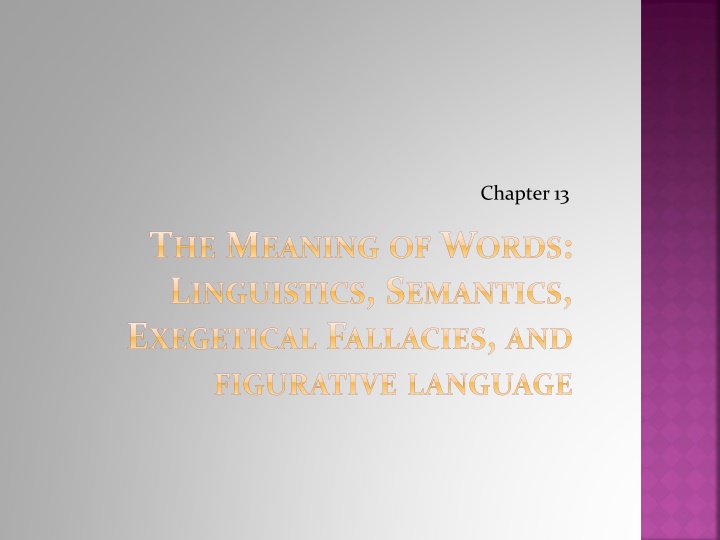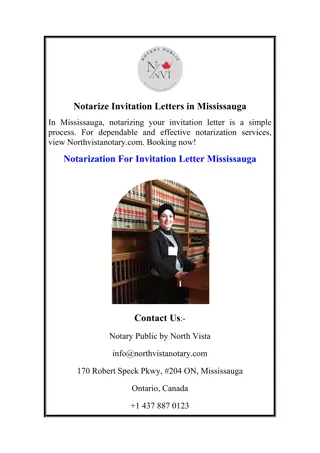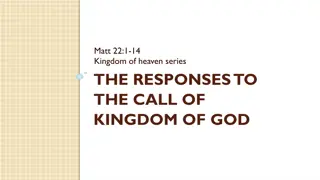
Linguistics, Semantics, and Word Meanings in Biblical Interpretation
Explore the significance of linguistics and semantics in understanding word meanings within the context of biblical interpretation. Delve into the science of semantics, linguistic conventions, and the nuanced meanings of words to avoid exegetical fallacies and navigate figurative language effectively.
Download Presentation

Please find below an Image/Link to download the presentation.
The content on the website is provided AS IS for your information and personal use only. It may not be sold, licensed, or shared on other websites without obtaining consent from the author. If you encounter any issues during the download, it is possible that the publisher has removed the file from their server.
You are allowed to download the files provided on this website for personal or commercial use, subject to the condition that they are used lawfully. All files are the property of their respective owners.
The content on the website is provided AS IS for your information and personal use only. It may not be sold, licensed, or shared on other websites without obtaining consent from the author.
E N D
Presentation Transcript
Chapter 13 THE MEANING OF WORDS: LINGUISTICS, SEMANTICS, EXEGETICAL FALLACIES, AND FIGURATIVE LANGUAGE
CHAPTER OUTLINE Linguistics: Nature of the Study of Languages Semantics: Science of Determining Word Meanings Context and Discourse: Interpreting the Parts in Light of the Whole From Word Study to Semantic Field Study: A More Excellent Way Guidelines for Determining Word Meanings Exegetical Fallacies: Pitfalls to Avoid in Determining Word Meanings Figurative Language: Nature and Issues
LINGUISTICS: THE NATURE OF THE STUDY OF LANGUAGES The linguistic forms in which Scripture has come down to us in the original Greek, Hebrew, and Aramaic are a reflection of the historical-cultural world in which God chose to reveal himself to his people in both Testaments. The failure to appreciate that we are dealing here with language, which by its very nature is subjective and varied in style and often eludes being reduced to a simple formula or rigid dictionary definitions, hinders much of common biblical interpretation.
LINGUISTICS: THE NATURE OF THE STUDY OF LANGUAGES In short, language is convention. The important lesson for us at this point is that there is nothing sacred, or absolute, about (insert picture) being an apple. Language is a human convention, and as such is subject to change or modification. Words have a history and can take on new meanings over time or acquire additional connotations. Unless we become students of language and literature as well as theology we will always be limited in our ability to accurately handle the word of truth.
SEMANTICS: THE SCIENCE OF DETERMINING WORD MEANINGS As we have seen, linguistics is the field of research devoted to a study of the nature of language. A related field of study is the area of semantics, the science of determining word meanings. People often think of the meaning of words as if each of them had an independent and separate existence. But ... no word can be fully understood independently of other words that are related to it and delimit its sense (John Lyons).
SEMANTICS: THE SCIENCE OF DETERMINING WORD MEANINGS Langue and parole. The former constitutes the language system in its entirety and the latter specific words chosen by the language user for the sake of written or oral communication. Language users have a variety of options in accordance with the parameters of a given linguistic system at large. Since our underlying hermeneutical purpose is the determination of authorially intended meaning, and authors have a number of linguistic options to convey a particular proportion or meaning, the larger linguistic system must be taken into account.
CONTEXT AND DISCOURSE: INTERPRETING THE PARTS IN LIGHT OF THE WHOLE Meaning is determined on the basis of the congruence of two factors, semantic field ... and context (Grant Osborne). The following guidelines will be helpful here: (1) semantic field (i.e., terminology) and context are both important for the study of a biblical concept; (2) context has priority over semantic field; (3) if the second point is kept in mind, semantic field seems to be a very appropriate starting point to guide one to at least some of the most relevant context which need to be considered in one s study of a concept.
CONTEXT AND DISCOURSE: INTERPRETING THE PARTS IN LIGHT OF THE WHOLE Rather than narrowly focusing on words in isolation, resulting in reductionism, part of the solution is an expansion of one s focus beyond words to concepts. Peter Cotterell and Max Turner draw the vital distinction between lexical and discourse concepts. In Revelation 13:1, the dragon who stood on the shore of the sea, in the larger discourse unit of which the verse is a part, is the great dragon, ... that ancient serpent called the devil, or Satan, who leads the whole world astray (Rev. 12:9).
FROM WORD STUDY TO SEMANTIC FIELD STUDY: A MORE EXCELLENT WAY The old-fashioned notion of word studies has in recent years been increasingly replaced by the more refined approach of what has been called a semantic field study. Semantic field is a particular set of words that are linguistically related, be it by synonymy, antonymy, or some other association of meaning. Louwand Nida, Greek-English Dictionary Based on Semantic Domains
FROM WORD STUDY TO SEMANTIC FIELD STUDY: A MORE EXCELLENT WAY Assume that your focus is on a study of wealth and poverty in the Gospel of Luke, a New Testament book where this theme is particularly prominent. Perhaps the best place for you to turn in order to locate specific instances of wealth and poverty vocabulary in the Gospel of Luke is The Book Study Concordance, which organizes the vocabulary of the New Testament book by book.
FROM WORD STUDY TO SEMANTIC FIELD STUDY: A MORE EXCELLENT WAY (1) ( poor ): 4:18: anointed me to proclaim good news to the poor 6:20: Blessed are you who are poor 7:22: the poor have good news preached to them, etc. (2) ( rich ): 6:24: But woe to you who are rich 12:16: The land of a rich man produced plentifully 14:12: When you give a dinner or a banquet, do not invite your ... rich neighbors, etc. (3) ( be rich ): 1:53: he has filled the hungry ..., and the rich he has sent empty away 12:21: So is the one who lays up treasure for himself and is not rich toward God 4) ( wealth, riches ): 8:14: choked by the cares and riches and pleasures of life
FROM WORD STUDY TO SEMANTIC FIELD STUDY: A MORE EXCELLENT WAY The value of semantic field studies for the Old Testament can be illustrated in a study of the word kill in the command You shall not kill (Deut. 5:17; ). The more recent translations of the Old Testament read You shall not murder. This change of wording is, in part, based on the recognition that the English word kill is more general than is the Hebrew.
EXEGETICAL FALLACIES: PITFALLS TO AVOID IN DETERMINING WORD MEANINGS
EXEGETICAL FALLACIES: PITFALLS TO AVOID IN DETERMINING WORD MEANINGS The Etymological Root Fallacy Misuse of Subsequent or Previous Meaning (Semantic Anachronism or Obsolescence) Appeal to Unknown or Unlikely Meanings or Background Material Improper Construalsof Greek or Hebrew Grammar or Syntax Improper Appeal to Alleged Parallels Improper Linkage of Language and Mentality False Assumptions about Technical Meaning
EXEGETICAL FALLACIES: PITFALLS TO AVOID IN DETERMINING WORD MEANINGS Improper Distinctions Made Regarding Synonyms Selective or Prejudicial Use of Evidence Unwarranted Semantic Disjunctions or Restrictions (Including Illegitimate Totality Transfer) Unwarranted Neglect of Distinctive Characteristics or Personal Style Unwarranted Linking of Sense and Reference
THE NATURE AND CHARACTERISTICS OF FIGURES OF SPEECH How Figures of Speech Work A figure of speech is a use of language in which there is a comparison, either stated or implied, between two terms. Figures of speech have two terms, or subjects, which are compared, or brought into a relationship of similarity (or contiguity). Vehicle and tenor The tenor in a figure of speech is its underlying subject the vehicle is the mode in which the tenor is expressed. Psalm 23
THE NATURE AND CHARACTERISTICS OF FIGURES OF SPEECH
THE NATURE AND CHARACTERISTICS OF FIGURES OF SPEECH How Figures of Speech Work Figures of similarity are those in which there is no logical connection between the two terms of the comparison (vehicle and tenor). Figures of contiguity, on the other hand, are based on some kind of logical association. Metonymy Synecdoche
THE NATURE AND CHARACTERISTICS OF FIGURES OF SPEECH Figures of Speech and Meaning Figurative language . . . is not antithetical to literal interpretation; it is a part of it (Roy Zuck). Figurative language conveys literal truth in the sense that the ideas in a biblical figure of speech are literally true. We understand a new idea when we see that it is (1) connected to an idea we already know; and (2) different from the old idea. Thinking is essentially analogical.
THE NATURE AND CHARACTERISTICS OF FIGURES OF SPEECH Figures of Speech and Meaning In metaphors and by extension all figures of speech two ideas are related in such a way that a new thought emerges. No one would ever invent or understand a new type of meaning unless he were capable of perceiving analogies. All thinking is, in other words, the process of metaphor. To understand that figures of speech in the Bible can convey cognitive concepts or theology alleviates the question of their function. They are not to be understood as imaginative pictures; rather, they are to be conceived as part of the theology of a given pericope. Figures of Speech and the Inexpressible
THE NATURE AND CHARACTERISTICS OF FIGURES OF SPEECH Figures of Speech and Context By its nature, metaphor is constituted by a relationship of two nouns. the rest of the discourse around the metaphor will provide hints as to which interpretation, of many, is appropriate for a given metaphor. It is the author s intention that regulates the meaning of the figures of speech he uses.
THE NATURE AND CHARACTERISTICS OF FIGURES OF SPEECH Figures of Speech and the Inexpressible The Bible frequently uses figures of speech in its language its words about the person and work of God. If we do not give these figures their due attention, we attenuate our understanding and grasp of the attributes and actions of God. Biblical figures of speech are one way the Holy Spirit mediates spiritual things to us. In the Old Testament, God is presented as a warrior, a shepherd, a king, as thunder and lightning, and as a husband. In the New Testament, Jesus is presented, among other figures, as the good shepherd, the living water, the bread of life, and the lamb of God.
THE NATURE AND CHARACTERISTICS OF FIGURES OF SPEECH Figures of Speech and the Inexpressible Images, particularly metaphors, help to communicate the fact that God is so great and powerful and mighty that he can t be exhaustively described. Metaphor may be accurate, but is less precise than literal language. Metaphor preserves the mystery of God s nature and being, while communicating to us about him and his love for us (Tremper Longman). Figures of speech teach us hermeneutical humility, because it is often difficult to determine the precise ideas they communicate.
ISSUES IN INTERPRETING FIGURES OF SPEECH IN THE BIBLE Figures of Speech and Literal Meaning Simply because a word has figurative meanings in one context does not mean that it is figurative in all contexts. Day The bread and wine in the Last Supper Vehicle and Tenor in Meaning Understanding the meanings and associations of important words in their historical contexts in short, the diachronic dimension to semantics will spare you error in interpretation. Eye of the needle (Matt. 19:24) Connotations and Denotations Denotation refers to the simple definition of the word in the dictionary. Connotation to the associations made with a word.
ISSUES IN INTERPRETING FIGURES OF SPEECH IN THE BIBLE Active Participation by the Reader Figures of speech demand active reading on the interpreter s part. Such reading is no spectator sport for the hermeneutically lazy or indifferent exegete. Figures of speech require far more activity than a direct, propositional statement does (Leland Ryken). Rest in Hebrews Figures of Speech and Contexts Of all the hermeneutical principles outlined in this chapter, context is the determinative factor in meaning. Parable of the tenants
ISSUES IN INTERPRETING FIGURES OF SPEECH IN THE BIBLE Figures of Speech and Propositional Explanations When a figure of speech is explained in its own context, there is no excuse for misconstruing its meaning. Leaven in Matthew
GUIDELINES FOR DETERMINING WORD MEANINGS Select the word or words to be studied. This should be a word that is significant for the interpretation of a given biblical passage. Make sure you study a given Greek or Hebrew term or set of terms, not the English one. This is important since, depending on the particular translation, a given Greek or Hebrew word will be rendered by several different English words and vice versa. What we want to study is what a given word means in the original rather than in English. 1. 2. 3. 4.
GUIDELINES FOR DETERMINING WORD MEANINGS Old Testament word studies have traditionally relied on a general knowledge of English synonyms and antonyms to find related English words and then worked back to the Hebrew (or Aramaic). Electronic resources improve on this process by giving the student access to the Hebrew lexicons without the formal study of the original languages. Another type of electronic resource is the reverse interlinear. 5. 6. 7.
GUIDELINES FOR DETERMINING WORD MEANINGS If studying, for example, the different words for love in the Gospel of John, both nouns and verbs, and perhaps also adjectives and adverbs, identify the specific words by looking up the word love in the index volume (Vol. 2) of Louw-Nida. Then locate the specific semantic domain (#25) in Vol. 1 of Louw-Nidaand determine which Greek words fall under this rubric. 8.
GUIDELINES FOR DETERMINING WORD MEANINGS Armed with this information, go to The Book Study Concordance and look up each of these Greek words under the respective heading. This will supply you with all the relevant data for your study (or at least the vast majority of relevant data). 10. Conduct a contextual study of all the relevant passages. In practical terms, one should start with passages for the target word. Lexicons and concordances can provide a quick overview of the semantic ranges for related words or can provide material for a more exhaustive (and sometimes exhausting) study. 9.
GUIDELINES FOR DETERMINING WORD MEANINGS In light of this semantic range, return to your base passage and see how it fits within the overall semantic profile of your word and what it contributes to the overall theology or concept or theme in question. 11.





















